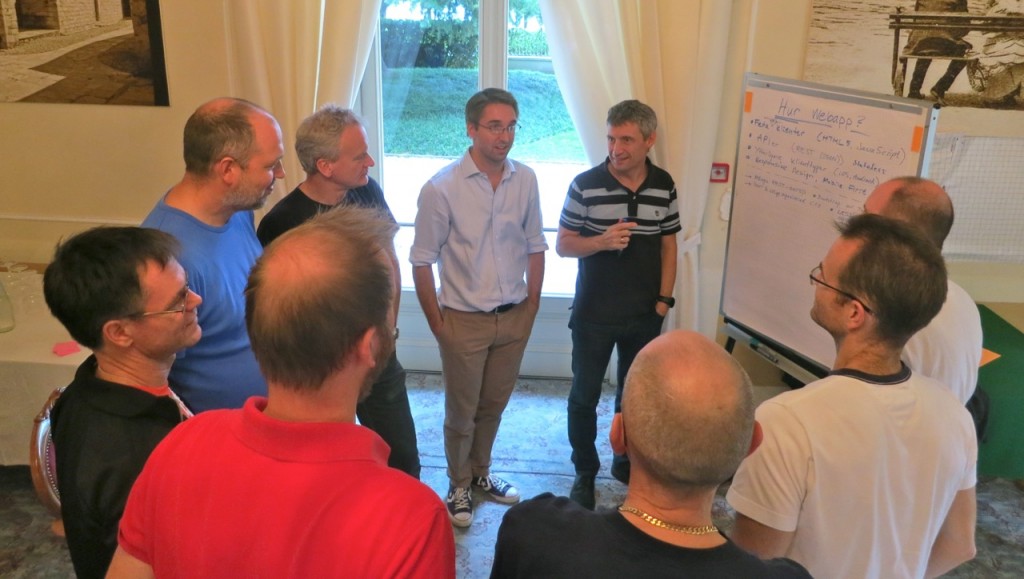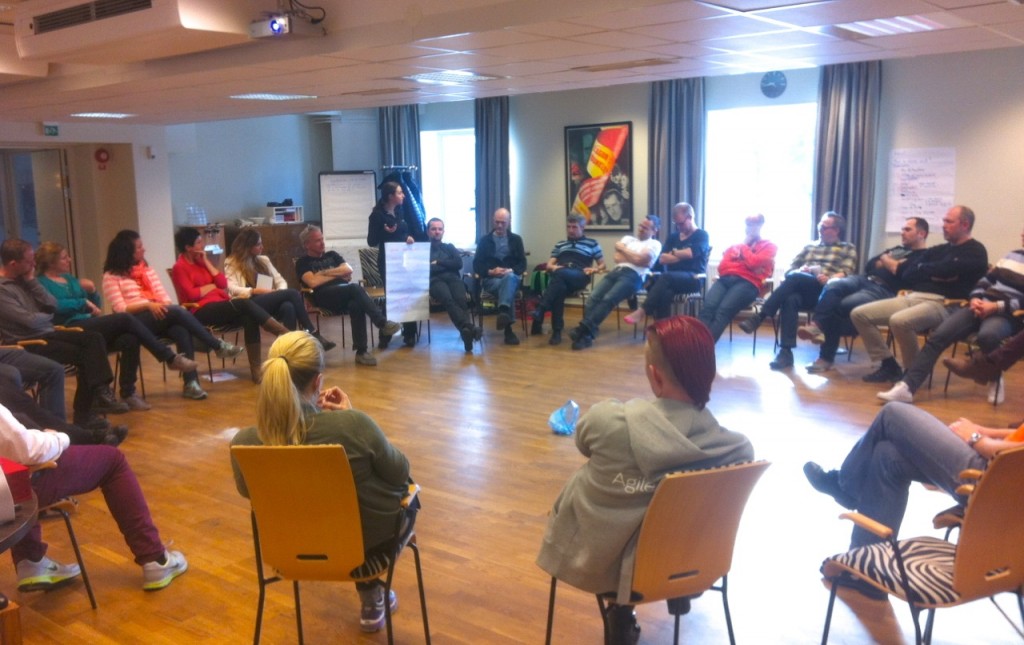We are 35 people at Crisp now, and we are a decentralized organized with no managers. So how do decisions get made? This article is a direct translation of our internal wiki page “Hur vi tar beslut på Crisp” (how we make decisions at Crisp).
<meta>So how did we decide on this decision-making process? Well, we didn’t. I just noticed that people sometimes ask “so how do we make decision” and I started thinking about how it appeared to work, and wrote a wiki page describing it. Then I had a followup meeting to check if this is how we really work, and if this is how we want to continue working, and the answer was pretty yes on both counts.</meta>
Note – for allocation of consultants to client engagements we have a specific protocol for that – the bun protocol. Similar for recruitment decisions.
Why don’t we have a well defined decision-making process?
We make lots of decisions all the time. Which type of coffee machine to buy? Should our internal fees be raised? Where & when is our next Crisp unconference? Which partners should we invite?
Different types of decisions need a different process. It would be crazy to involve the whole team in decisions like which type of whiteboard pens to buy. And it would be crazy to NOT involve the whole team in questions related to organizational structure, or the team membership fee [at Crisp, consultants aren’t employed – they each have their own company and pay a membership fee to be part of Crisp].
So it’s not a good idea to have one single well-defined decision process for everything. And it’s not a good idea to try to list all potential decision types and create a well-defined process for each type, the list would be too long and complex, and there would be too many gray zones.
Well, how do we make decisions then?
You don’t need a well-defined decision process in order to make decisions. If that was the case, the world would stand still 🙂
Instead, we follow these principles/guidelines:
- The person driving an issue owns the decision process.
- A decision is only a decision if there is a “puller” who follows up on the execution. [we use the term “driver” and “puller” interchangably]
- Important decisions should be documented in our decision log [a simple google spreadsheet showing date, what the decision was, who is affected, and who was involved].
- Some decisions lead to financed “projects”, like our new website [the people involved in something like that form a “crisplet”]. To get financing, there needs to be two “pullers” throughout the whole project. [in practice, we seldom have big projects and rarely need to use this model]
Example: If the board is considering to raise the team fee, the board drives that question, and therefore gets to pick the decision process.
Example: If I want Crisp to collaborate with company X, then I’m the one driving that question and I pick the decision process.
When a decision is made and it affects more than just yourself, send an email to the team mailing list.
How do I pick a decision process?
Here are some exampels of different decisions processes on a scale from “fast” to “well-anchored”.
- Own decision. Decide yourself without talking to anyone.
- Own decision with team input. Ask for input from the team, but then make the decision yourself.
- Own decision with team-anchoring. Ask for input from the team, suggest a decision, check if the team is OK with it before closing the decision.
- Team decision. Facilitate a decision from the whole team (normally through concensus, with majority vote as fallback if we can’t reach consensus).
The term “team” in this case really means “those who are affected by the decision”. Sometimes the whole team, sometimes just a few individuals.
These decisions processes can be combined. For example, start by getting input from the whole team, then suggest a decision and anchor with those people who are most directly affected.
Some things to consider when choosing a decisions process:
- Who is affected? Only you? You and a few others? The whole team?
- How important is this question for you? How important is it for those who are affected? Is it a critical decision or trivial one?
- Is the decision reversable [most decisions are]? What is the consequence of making the “wrong” decision, and who is affected by that?
- How easy or hard is the decision? How easy is it to reach consensus with all people affected?
- How urgent is the decision? What is the consequence of delaying the decision, or not making a decision at all?
- Who are you? The decision process may vary depending on your perspective – consultant, board member, office admin, etc. May also depend on how long you’ve been at Crisp (if you are new and unsure you might need to seek more anchoring from people).
Sample decisions:
- “Should I arrange a free seminar with Lyssa Adkins” => Own decision. Just do it.
- “Which color should we have on the Crisp cup?” => Own decision with team input.
- “How often should we do Crisp unconferences?” => Own decision with team anchoring.
- “Should we divided the company into two business units?” => Team decision.
At the end of the day it’s about balancing risk. If you make the decision yourself it will be fast, but you risk a backlash if others don’t support it. If you seek 100% consensus you may get a better decision with better support, but it could take time – especially for questions where people have opposing opinions.
There is no perfect process, so seek a balance between these extremes! We most often end up in the middle of the scale – “own decision with team input” or “own decision with team anchoring” (where “team” isn’t necessarily the whole team)
What do I do if I still feel unsure of which decision process to use?
- Take a chance! “Better to ask for forgiveness than permission”. Most decisions are reversible, so you don’t really need to be afraid of making the “wrong” decision or using the “wrong” decision process. Just accept feedback and learn
- Talk to a Crisp colleague, for example someone who has been around longer and can give examples of what we’ve done in the past.
- Check if someone else can drive the question for you (or with you). Preferably someone who is strongly engaged in the question. For example if I want next Crisp unconference to be in the Maldives I’d involve Jennie in the decision process, since she usually arranges our unconferences. It’s nice to pair-drive a decision, so you can always ask on the team mailing list to find a co-driver.
- Escalate the decision to the board of directors. For example “hey board, I want to change our recruiting process, how would we make a decision like that?”. We try to minimize the number of decisions that have to be made by the board, but they can give useful input about who needs to be involved.
Unconferences and Pulse meetings [mini-unconferences] are a great place to discuss a decision process – and in many cases make the actual decision as well, since everyone is there 🙂
So, decision making can look like this:
… or like this, for slightly bigger issues:
… or like this, for big issues that affect everyone:
I think that was the meeting where we decided to remove the CEO role. For a few years we’d had a rotating CEO role, timeboxed to 30% of fulltime. A small group (including the current CEO) discussed the issue during an open space session, and brought up the concrete proposal to the whole team at the end of the unconference. A quick consensus check (via thumb vote) and the decision was done! We agreed that the CEO role had fulfilled a purpose, but now the office team was capable of dealing with stuff without having a CEO.
(and what happened to the current CEO? Well, he was happy to be able to drop the role and go back to client-facing work!)
PS – to learn more about how we run our unconferences, see “How to run an internal unconference“. The open format is quite essential to our decision making process.







Henrik, thank you for sharing this decision un-process. How refreshing.
Hi Henrik,
thanks for sharing, very interesting. I like the idea that the driver is simply trusted to choose the appropriate decision process.
A couple of questions:
Do you announce the decision process beforehand?
Did it happen that people changed the decision process during the decision?
How are people new with Crisp learning this?
My guess (partly based on my experience with my former company oose) is, that it is quite a challenge as a driver to really clarify for yourself what your decision process is. That it needs a lot of experience.
Relating to Daniel Kahnemanns work, my guess is that our “System 1” often replaces the question: “What is the appropriate decision process?” with “What is an easy decision process?”, so that -even without bad intent- people are choosing the decision process that favors their preferred decision.
Any takes on that?
> Do you announce the decision process beforehand?
Usually not. Only for very sensitive decisions.
> Did it happen that people changed the decision process during the decision?
Yes. Sometimes people turn out to be way more engaged (or way less engaged) than the driver thought, so the decision process needs to be adjusted on the fly.
> How are people new with Crisp learning this?
Word of mouth. This article helps too. But new people are often confused about our decision-making process, so we could definitely improve our internal communication around this. Fortunately we don’t grow so fast so it’s not a big issue.
I agree with your guesses and comments. People are naturally biased. That’s why we encourage people to pair-drive decisions, that tends to reduce (or at least reveal) biases. For sensitive decisions we try to find drivers who are unengaged in the result (a bit of a paradox, but it usually works). Most decisions aren’t very sensitive though, and easily reversible, so the important thing is to get on with the decision and not get blocked unnecessarily.
Might the #AntimatterPrinciple be useful here? We found it so at Familiar – a company seemingly built along many of the same lines as Crisp.
– Bob
I’m all for this, and we seem to be channelling Ricardo Semler from a generation ago.
Be interesting to see how this sort of thing scales. Semlers company is reasonably big so possible it would seem.
I’ve been reading that this is now happening a bit more elsewhere, can’t remember who someone in the USA, but keen and interested to see this go further.
File under conscious capitalism?